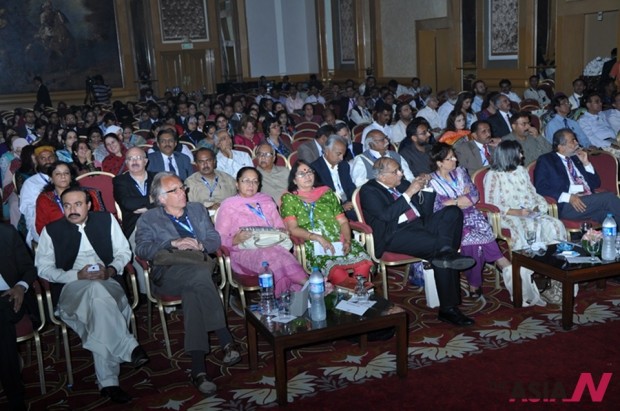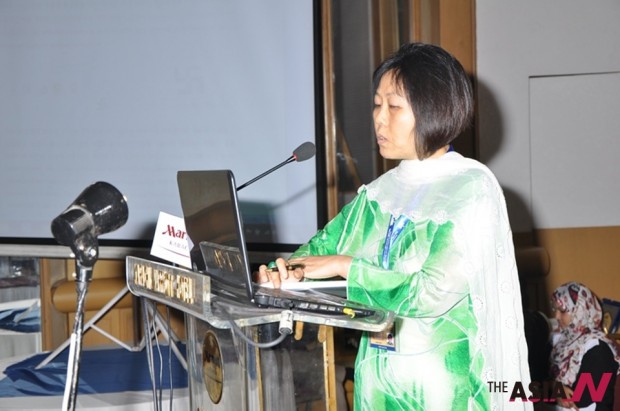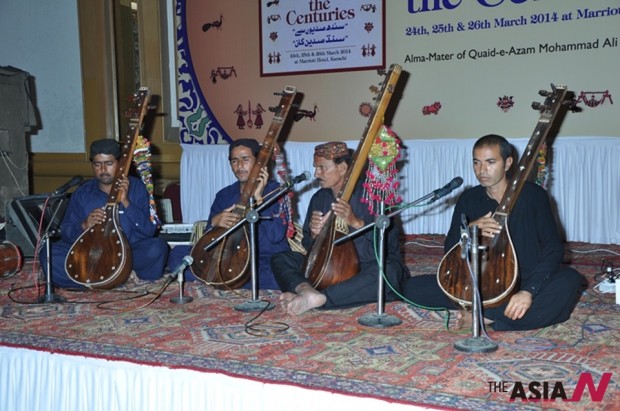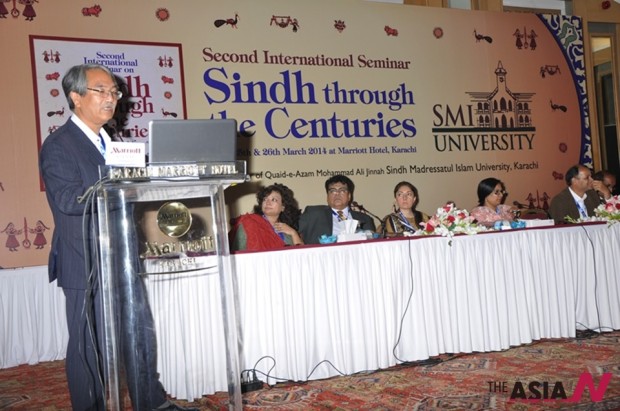Sindh through Centuries
Korean, Japanese, Indian, American, German and other research scholars explore hidden aspects of Great Indus Civilization
Around 25 foreign research scholars from South Korea, Japan, India, USA and Germany joined local historians and scholars at 3-day International Seminar on ‘Sindh through Centuries’ from March 24 to 26, 2014 at Karachi, the port city and capital of Sindh province of Pakistan to explore different aspects of Great Indus Valley Civilization. The seminar was second of its nature held after 39 years by Sindh Madressatul Islam (SMI) University Karachi. The SMI itself is a historic institution established by Hassan Ali Effandi, a Sindhi (native of Sindh) in nineteenth century to impart modern education to the people of this region. The school grew since then and now has got the status of University. The first seminar on ‘Sindh through Centuries’ was organized in March 1975 under the patronage of then Prime Minister of Pakistan, Zulfiqar Ali Bhutto. This time credit goes to Dr. Muhammad Ali Shaikh, Vice Chancellor of SMI University.
Presenting the paper on comparative study on gridiron planning from America to Indus Valley Civilization, Ms. Javeria Shaikh, doing PhD at the School of Architecture, Hanyang University, South Korea under her Professor JaeSeung Park, said the paper intended to identify the trends over the time for anthropological living settlement patterns and chronology of compact city plan. Scholar quoted Stanislawski as saying in 1946 that the origin of the grid (type of city plan in which streets run at right angles to each other forming a grid) was Mohen Jo Daro.
Dr. Andre Wink, Professor of History, University of Wisconsin-Madison, USA, in his paper said: “The Mongol conquests and migrations in Sindh and other Indus borderlands in the thirteenth and fourteenth centuries were not only responsible for the destruction of sedentary agriculture and village life in many areas but equally led to demise or weakening of existing patterns of culture and religion.
“The destruction of culture, religion and social cohesion over two centuries of Mongol conquests and tribal migrations, in combination with pervasive nomad-ization and raiding paved the way for subsequent conversion to Islam and formation of new pir-and-shrine-centered forms of religious organization,” he said.
Dr. Mathew A. Cook, Assistant Professor of Post-Colonial & South Asian Studies at North Carolina Central University, in his paper ‘The annexation of Sindh and socio-cultural distinctions’ said local support for the British in 1843 hinged on internal social relations among Hindus and attempts to challenge distinctions of status within this community.
His paper looked beyond the imperial great game and economic rationalism in the global expansion of British Empire. He focused on how Hindu merchants supported the British Empire. According to the US scholar, the British Empire provided property security and types of institutional stability that indigenous states were incapable of guaranteeing.
Esther Park, a South Korean research scholar working as visiting professor at Fatima Jinnah University, Islamabad, said: “The earliest archeological evidence of Swastika-shaped ornaments, a symbol of auspiciousness in Hinduism, Buddhism and Jainism, dates back to Indus Valley Civilization as well as the Mediterranean Classical Antiquity and Paleolithic Europe.”
In her paper she focused on Swastika-shaped ornaments found in Mohen Jo Daro and other parts of Sindh and its significance through centuries.
Esther Park said Swastika word comes from Sanskrit Svastika – ‘su’ (meaning good or auspicious) combined with ‘asti’ (meaning it is) along with diminutive suffix ‘ka’. The Swastika literally means ‘it is good’. Esther Park is married to a Pakistani and lives here since last ten years.
Michel Boivin, director of research at CNRS (National Center for Scientific Research), who specializes in anthropological history of Muslim countries in South Asia, presented his paper on ‘Language, Literature and building of Sufi culture in colonial Sindh’.
Dr. Jurgen Schaflechner, an Austrian and teacher at a German University, having done Masters on South Asian Languages & Literature, Comparative Religion & Classical Ideology, presented paper on ‘The Shrine of Hinglaj Devi’, and focused on how the shrine in Balochistan had been rearticulated in different time-periods to appropriate political claims.
Dr. Supriya Banik Pal, a former Associate Professor in the Department of Sanskrit at Sarat Centenary College, India, presented paper on ‘Sindhu or Sindh: A study through the Mahabharata’ exploring the rich heritage and culture of Sindh in the light of epic Mahabharata.
Ms. Suman Sonkar, an Indian scholar, said: “Pakistan provides an opportunity for Central Asian countries to diversify their international connections and to reduce the distance and the number of borders to be crossed to reach international maritime transportation hubs. For instance, the Central Asia-Afghanistan-Pakistan (Karachi Port) road corridor would provide potentially one of the cheapest and probably the quickest routes to Central Asia.”
In her paper titled ‘Revival of new Silk Route through Sindh’ Ms. Suman, the professor of economics at Lakshmibai College, University of Delhi, highlighting the existing overland silk transport corridor between Pakistan and China, explored the possible options to enhance the transport linkages from port of Karachi through Karakoram Highway and further to Central Asian region. “The study of the trade route will help in the development of the entire region,” she added.
She said it is the ancient passage that has connected the civilizations and thus promoted the multi-interchange between East and West. “This ancient route not only circulated goods but also exchanged the splendid cultures of China, India, Pakistan, Persia, Greek and Rome.”
According to her Sindh has the potential to become an important transit route between South Asia and Central Asia.
Hiro Thakur, another eminent scholar from India, speaking about courageous cattle traders and seafarers of ancient Sindh, said Rig Veda, the oldest Hindu composition suggests that the Panis were inhabitants of ancient Sindh and known as valiant, wealthy people who used to process enormous wealth of cows and horses.
Dr. Kamla Goklani, another scholar from India presented paper on ‘Comparative study of West Rajasthani and Sindhi Language’ highlighting similarity in Sindhi and Rajasthani languages.
Dr. Thomas Darnhardt from Ca’ Foscari University of Venice in his paper pointed out the presence of a cross-cultural devotional cult, deeply rooted in the imagination of popular Sindhi culture in which both Hindus and Muslims devotees joined in some places in Sindh.
US scholar, Jonathan Mark Kenoyer from University of Wisconsin said that Indus technologies such as metallurgy, ceramics, ornaments, textiles and writing provided a unique window into the socio-economic, ideological and political organization of the early Indus cities during the Harappa Phase of the Indus Tradition.
He said that study of seals and artifacts from the major sites of Harappa and Mohen Jo Daro, and Lakhan Jo Daro, Pakistan and Dholavira and other sites in Gujarat, India provide a new understanding of the complex nature of internal trade between the major regions of Sindh, Punjab, Balochistan and Gujarat.
In his research paper, Atsushi Noguchi, researcher at Archeological Investigation Unit, of Meiji University, Tokyo, Japan, said: “Sindh keeps its unique position through more than 1.5 million years of incredible human history. Hand-axes and cleavers, the oldest form of stone tools, found in the Rohri Hills could be clues of Afro-Asian connection 1.5 million years ago. This shows us the route of the earliest migration of hominids out of Africa into Eurasia.”
Noguchi said another stone tool component from Veesar Valley in the Thar Desert, where Pakistan-Japan Archaeological Mission is now running a joint research project, has big potential in revealing the history of encounter with and replacement of Archaic Homo by Homo sapiens.
In the Thar Desert, new micro-blade technology appeared around the saline Duhbi Lakes at the western fringe of the desert. He maintained that in Middle Eastern cases, hunter-gatherers with micro-blade technology intensified interaction with herds, learnt controlling and maintaining them, and finally achieved to be the first herders. This probably happened in the Thar Desert in same way.
A five-year study by a Japanese research team has found that thousands of years ago, several cities in the Indus Valley, in what is today Pakistan and India, created a trade network that became a multicultural, multilingual civilization, and not a society founded on centralized authoritarian rule as previously believed.
“Many characteristics of this ancient civilization can be seen today in societies of southern Asia”, said Toshiki Osada, head of the team of Japanese researchers in his paper.
Toshiki Osada, Professor Emeritus of the Research Institute for Humanity and Nature, Kyoto, Japan, was head of the team of researchers that painted the fresh image of the Indus civilization through five years of research, known as the Indus Project. “Different regional communities created a loose network through trade”, Osada and his team members concluded in their research.
He said that two of the more well-known ruins of the Indus civilization are Harappa and Mohen Jo Daro, both in Pakistan. Currently, most researchers focus on the ruins of five major urban centers: the two famous sites; Pakistan’s Ganeriwala, which is in a desert; India’s Dholavira, which is on an island in a marsh; and Rakhigarhi, also in India.
The common view is that the desert sites used to have rivers other than the Indus flowing nearby. Researchers, led by Hideaki Maemoku, a physical geography expert and professor at Japan’s Hosei University, examined the area around the desert ruins with a dating method based on mineral crystals. The conclusion is that the cities were built on these dunes only after the river was long gone.
Japanese scholar said that at Dholavira, artifacts suggest thriving maritime trade. The most likely candidates for this trade are the ancient societies in Mesopotamia, which could have been reached via the Arabian Sea. He stated that the Indus project found that sea levels were around 2 meters higher and the coastline was much deeper inland. This suggests that many of the ruins in the area were along the ancient shoreline and that this part of the Indus civilization was dependent on the ocean”, he opined.

































































